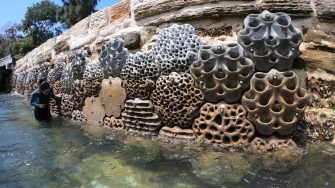
The Living Seawalls project aims to enhance the ecological value of artificial structures in the marine environment such as seawalls and pilings. We're currently assessing the ecological benefits of scaling up greening interventions on coastal infrastructure by adding different types of habitat-enhancing units to seawalls, pilings and breakwaters in Australia and worldwide.
Current research projects:
-
Living Seawalls habitat panels are designed based on nature and mimic different features, such as crevices and rock pools, which are often found on natural shorelines but that are missing from infrastructure. Living Seawalls can now be found in 21 locations in Australia and 6 countries around the world!
-
Most eco-engineering projects to date have focused on seawalls, overlooking other types of infrastructure, such as wharf pilings, despite their prevalence and documented impacts. Therefore, we have developed habitat enhancement units to be installed on wharf pilings, with similar principles to the Living Seawalls habitat panels, with the aim to enhance biodiversity on these structures. The first ‘Living Pilings’ were installed in Sawmillers Reserve in 2024, and we are conducting regular monitoring to assess fouling and fish biodiversity.
-
Coastal engineering structures, such as revetments and breakwaters, protect shorelines and coastal assets from erosion and flooding but their use is often accompanied by significant ecological impacts. Based on the success of the Living Seawalls, we have developed Living Boulders – habitat modules that can be integrated into new or existing revetments and breakwaters to enhance their ecological value. These modules have recently been installed in Lavender Bay and their effectiveness in enhancing local biodiversity is being regularly monitored.

People involved:
- Mariana Mayer-Pinto
- Orla McKibbin
- Aria Lee
- Janine Ledet
Read more about Living Seawalls, Pilings and Boulders on the Living Seawalls website
